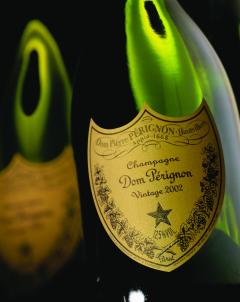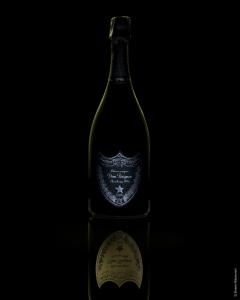Richard Geoffroy's Dom Perignon Challenge
POSTED ON 18/07/2010As I arrived at Moët et Chandon’s posh premises in Grosvenor Crescent to taste the new 2002 Dom Pérignon with its affable chef de cave Richard Geoffroy, I received an email from a friend looking for a 'special' bottle (possibly - but not necessarily - magnum) of champagne for a family friend's 90th birthday. ‘My impressionistic take is that you pay for the label with Dom Pérignon etc. So best to avoid'.
Given the coincidence, it seemed apposite to show this to Geoffroy for his view. The momentary hiss of steam I thought I detected coming from his ears had nothing to do with the clammy weather outside. But being the kind of man he is, i.e. open-minded with a sense of humour, he didn’t take it too badly. ‘It’s what in the glass that counts and not on the label. I’ll challenge anyone to deny it’s true in the case of Dom Pérignon’. We were about to find out.

Moët et Chandon’s Dom Pérignon bubblemeister was in town to launch the new 2002 Dom and two 1996 vintages of Dom, the Oenothèque and the straight Dom.The champenois are articulate in a way only the French can be when it comes to talking about their champagnes, but few are more articulate than Geoffroy, who's an interesting mixture of both coy and expansive about the Dom itself, over which he's presided for about 20 years. But he can straight-talk too. Example, on the 1996 vintage. 'Some 1996s are insane. They have all the attributes of great wine, the only problem is you can't drink them'. On fellow winemakers: 'many winemakers are losing focus because they're on an ego trip'.
Geoffroy starts by talking about the Dom Pérignon style. There are champagnes that are more traditional in style, he tells us, often with more black grapes, with high acidity and with more tannins. Dom Pérignon is not that traditional but more singular in character. Yes it's traditional in its timeless spirit, but not in the technicalities. It commits to simple but firm principles, of vintage character and of the blending of black and white grapes from 17 grand cru vineyards, of which 16 are owned by Moët & Chandon.
 Make mine a DP © Moët et Chandon
Make mine a DP © Moët et Chandon
'Dom Pérignon is about sensations on the palate, a relationship of weight to intensity, about texture, mouthfeel and the way the wine lingers and forms a memory of the wine itself. It's the opposite of oxidative. It's reductive. The intensity derives more from precision and harmony than power and it's recognised for its definition, its laser print, its harmony. The quality of the aromatics, the vibrancy is crucial. The essence of Dom Pérignon is yeast maturation and its destiny is to keep maturing on the lees'. Hence the development of the Dom Pérignon Oenothèque, which is disgorged much later than the straight vintage Dom Pérignon. 'Only after 80 – 100 years do you get yeast ghosts when the yeast cells become mere empty hulks'.
So we taste the 2002 Dom Pérignon, the product of a great vintage, to be released later in September, price from £120. Disgorged in early 2009, it's pale, with a fine bead, already showing impressive toasty characters on the nose with an appley crispness and a touch of vanilla and almond; it's rich and surprisingly opulent on the palate, a subtly textured mousse with a leesy, almost white Burgundy-like quality, youthful, winey, a mineral, almost salty freshness allied to a youthful lemony zip complemented by honeyed undertone. This is a joy to taste and no doubt, in the future, to drink. 95+ /100
Introducing the 1996 Dom Pérignon Oenothèque, Richard Geoffroy says that 1996, much anticipated at the time, was a year of big disappointments and very varied in style and quality. There was a concentration of dehydration in the grapes which often produced more intense flavour [than 1995] and yet not necessarily the required ripeness. 'Acidity on its own is not the key', he says.

Disgorged in the second half of 2008, the 1996 Dom Pérignon Oenothèque (from £200, top retailers) is pale, light and lemony in colour, remarkably youthful looking in fact. It's very toasty on the nose, almost smoky in fact and again Burgundian in a Meursault-like way, with a lovely intense nuttiness of flavour and gentle yet persistent mousse, its fruit sweetness tempered by a savoury, mineral dry tang and nutty finish. It's a lovely champagne and very different from the 1996 Dom Pérignon. 95 / 100. Disgorged in 2002, it seems more linear, softer and richer than the Oenothèque,a slight citrus and minty character on the nose with notes of toastiness and a honeyed aftertaste perhaps derived from a higher dosage of 10 grams compared to the Oenothèque's 6 grams. 91 / 100
Geoffroy finishes by telling us that he's keen to keep growing the fraction of Oenothèque that's made to the point at which Oenothèque takes over from Dom Pérignon itself. Then it's back to blending and intensity. 'Blending is almost a yin-yang principle, the aim being to restore a state of duality, of youth and maturity, of rigour and generosity, of apparent fragility and a statement of presence. My brief is to make wines that are invitingly user-friendly'. Yes, Richard Geoffroy could talk the proverbial hind legs off the donkey, and yet he meets the challenge he sets himself: ultimately to let the wine speak for itself. I sent my friend who’d emailed me a list of champagne recommendations. ‘Sue went for the Dom Pérignon 2000. So you can tell M. Geoffroy that marketing and all the hype does still pull them in'. I didn't put it quite that way, but I did tell him she'd gone for the DP.

